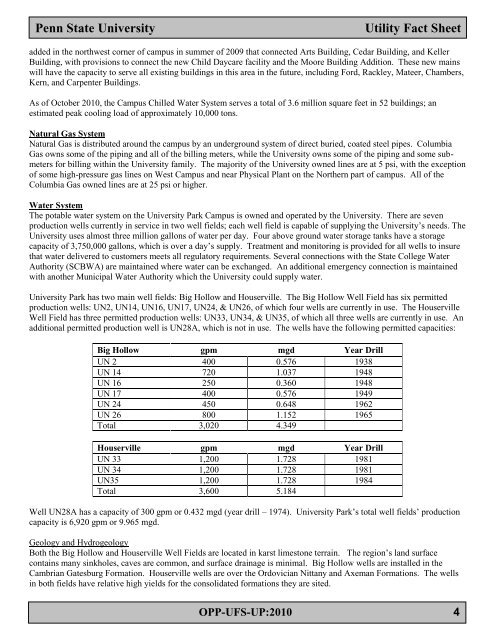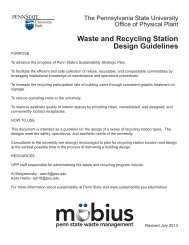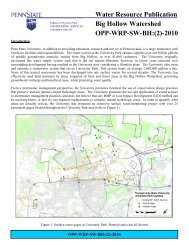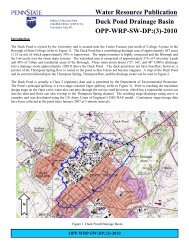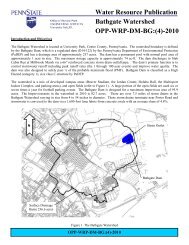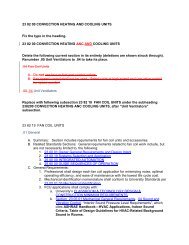Utility Fact Sheet - Office of Physical Plant - Penn State University
Utility Fact Sheet - Office of Physical Plant - Penn State University
Utility Fact Sheet - Office of Physical Plant - Penn State University
Create successful ePaper yourself
Turn your PDF publications into a flip-book with our unique Google optimized e-Paper software.
<strong>Penn</strong> <strong>State</strong> <strong>University</strong><br />
<strong>Utility</strong> <strong>Fact</strong> <strong>Sheet</strong><br />
added in the northwest corner <strong>of</strong> campus in summer <strong>of</strong> 2009 that connected Arts Building, Cedar Building, and Keller<br />
Building, with provisions to connect the new Child Daycare facility and the Moore Building Addition. These new mains<br />
will have the capacity to serve all existing buildings in this area in the future, including Ford, Rackley, Mateer, Chambers,<br />
Kern, and Carpenter Buildings.<br />
As <strong>of</strong> October 2010, the Campus Chilled Water System serves a total <strong>of</strong> 3.6 million square feet in 52 buildings; an<br />
estimated peak cooling load <strong>of</strong> approximately 10,000 tons.<br />
Natural Gas System<br />
Natural Gas is distributed around the campus by an underground system <strong>of</strong> direct buried, coated steel pipes. Columbia<br />
Gas owns some <strong>of</strong> the piping and all <strong>of</strong> the billing meters, while the <strong>University</strong> owns some <strong>of</strong> the piping and some submeters<br />
for billing within the <strong>University</strong> family. The majority <strong>of</strong> the <strong>University</strong> owned lines are at 5 psi, with the exception<br />
<strong>of</strong> some high-pressure gas lines on West Campus and near <strong>Physical</strong> <strong>Plant</strong> on the Northern part <strong>of</strong> campus. All <strong>of</strong> the<br />
Columbia Gas owned lines are at 25 psi or higher.<br />
Water System<br />
The potable water system on the <strong>University</strong> Park Campus is owned and operated by the <strong>University</strong>. There are seven<br />
production wells currently in service in two well fields; each well field is capable <strong>of</strong> supplying the <strong>University</strong>’s needs. The<br />
<strong>University</strong> uses almost three million gallons <strong>of</strong> water per day. Four above ground water storage tanks have a storage<br />
capacity <strong>of</strong> 3,750,000 gallons, which is over a day’s supply. Treatment and monitoring is provided for all wells to insure<br />
that water delivered to customers meets all regulatory requirements. Several connections with the <strong>State</strong> College Water<br />
Authority (SCBWA) are maintained where water can be exchanged. An additional emergency connection is maintained<br />
with another Municipal Water Authority which the <strong>University</strong> could supply water.<br />
<strong>University</strong> Park has two main well fields: Big Hollow and Houserville. The Big Hollow Well Field has six permitted<br />
production wells: UN2, UN14, UN16, UN17, UN24, & UN26, <strong>of</strong> which four wells are currently in use. The Houserville<br />
Well Field has three permitted production wells: UN33, UN34, & UN35, <strong>of</strong> which all three wells are currently in use. An<br />
additional permitted production well is UN28A, which is not in use. The wells have the following permitted capacities:<br />
Big Hollow gpm mgd Year Drill<br />
UN 2 400 0.576 1938<br />
UN 14 720 1.037 1948<br />
UN 16 250 0.360 1948<br />
UN 17 400 0.576 1949<br />
UN 24 450 0.648 1962<br />
UN 26 800 1.152 1965<br />
Total 3,020 4.349<br />
Houserville gpm mgd Year Drill<br />
UN 33 1,200 1.728 1981<br />
UN 34 1,200 1.728 1981<br />
UN35 1,200 1.728 1984<br />
Total 3,600 5.184<br />
Well UN28A has a capacity <strong>of</strong> 300 gpm or 0.432 mgd (year drill – 1974). <strong>University</strong> Park’s total well fields’ production<br />
capacity is 6,920 gpm or 9.965 mgd.<br />
Geology and Hydrogeology<br />
Both the Big Hollow and Houserville Well Fields are located in karst limestone terrain. The region’s land surface<br />
contains many sinkholes, caves are common, and surface drainage is minimal. Big Hollow wells are installed in the<br />
Cambrian Gatesburg Formation. Houserville wells are over the Ordovician Nittany and Axeman Formations. The wells<br />
in both fields have relative high yields for the consolidated formations they are sited.<br />
OPP-UFS-UP:2010 4


